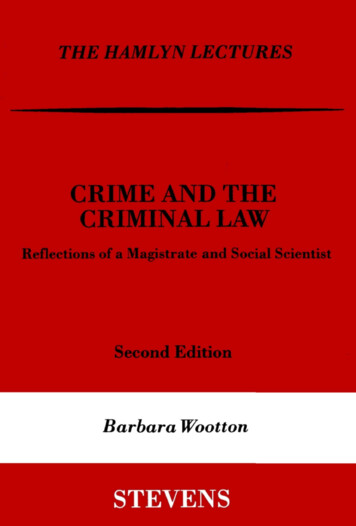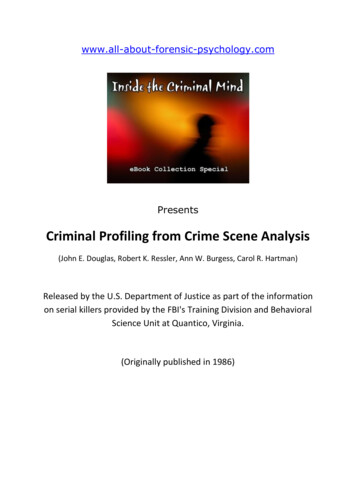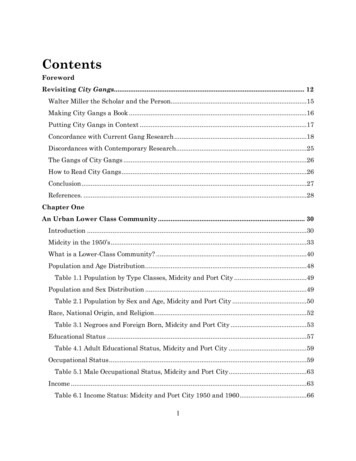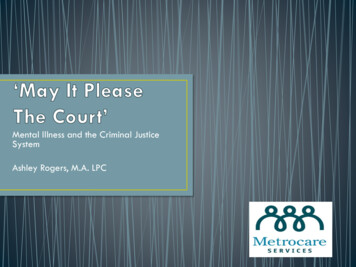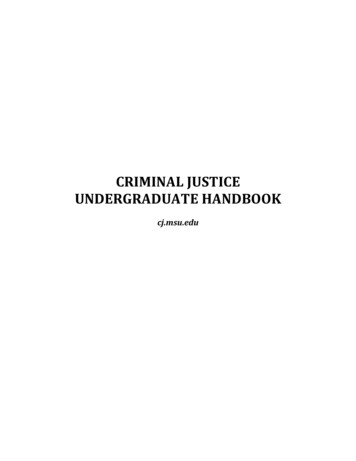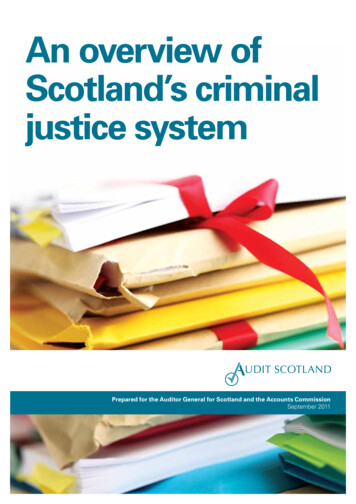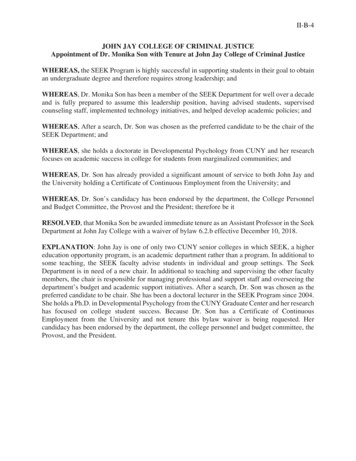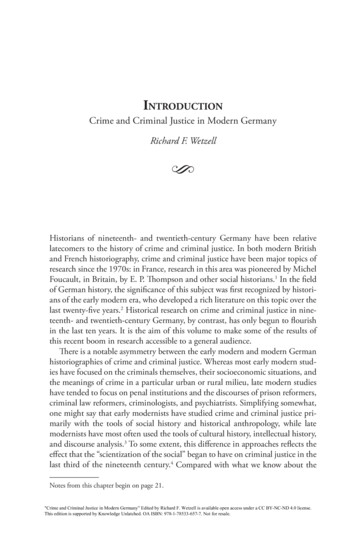
Transcription
IntroductionCrime and Criminal Justice in Modern GermanyRichard F. WetzellSHistorians of nineteenth- and twentieth-century Germany have been relativelatecomers to the history of crime and criminal justice. In both modern Britishand French historiography, crime and criminal justice have been major topics ofresearch since the 1970s: in France, research in this area was pioneered by MichelFoucault, in Britain, by E. P. Thompson and other social historians.1 In the fieldof German history, the significance of this subject was first recognized by historians of the early modern era, who developed a rich literature on this topic over thelast twenty-five years.2 Historical research on crime and criminal justice in nineteenth- and twentieth-century Germany, by contrast, has only begun to flourishin the last ten years. It is the aim of this volume to make some of the results ofthis recent boom in research accessible to a general audience.There is a notable asymmetry between the early modern and modern Germanhistoriographies of crime and criminal justice. Whereas most early modern studies have focused on the criminals themselves, their socioeconomic situations, andthe meanings of crime in a particular urban or rural milieu, late modern studieshave tended to focus on penal institutions and the discourses of prison reformers,criminal law reformers, criminologists, and psychiatrists. Simplifying somewhat,one might say that early modernists have studied crime and criminal justice primarily with the tools of social history and historical anthropology, while latemodernists have most often used the tools of cultural history, intellectual history,and discourse analysis.3 To some extent, this difference in approaches reflects theeffect that the “scientization of the social” began to have on criminal justice in thelast third of the nineteenth century.4 Compared with what we know about theNotes from this chapter begin on page 21."Crime and Criminal Justice in Modern Germany” Edited by Richard F. Wetzell is available open access under a CC BY-NC-ND 4.0 license.This edition is supported by Knowledge Unlatched. OA ISBN: 978-1-78533-657-7. Not for resale.
2 Richard F. Wetzellearly modern era, our knowledge of the history of crime and criminal justice inthe various German states in the first two-thirds of the nineteenth century is verylimited. Although we are beginning to learn more about the important transformations of criminal justice that took place in this period,5 most late modernresearch on crime and criminal justice picks up after the German unification of1871, a fact that is reflected in this collection.The essays collected here do not just provide pioneering contributions towarda history of crime and criminal justice in Germany from about 1871 to the 1950s,but connect the history of criminal justice to the larger questions of Germanpolitical history from the Kaiserreich to the two postwar Germanies, examine theincreasingly close but difficult relationship of criminal justice to psychiatry andsocial welfare, analyze the representations of crime and criminal justice in themedia and literature, and also use criminal justice history to illuminate Germansocial history, gender history, and the history of sexuality.Criminal Justice in Imperial GermanyA central part of the founding of Imperial Germany in 1871 was the ambitionto establish a uniform legal system throughout the German Reich. This ambitionmanifested itself in the quick passage of a Reich Penal Code (Reichsstrafgesetzbuch, 1871), which superseded the penal codes of the individual German statesand was modeled on the Prussian Penal Code of 1851,6 a Reich Law on theOrganization of the Courts (Gerichtsverfassungsgesetz, 1877), and a Reich Codeof Criminal Procedure (Strafprozessordnung, 1877).7 Despite wide-ranging support for the establishment of a unified prison system, the goal of a Reichsstrafvoll zugsgesetz (Reich Prison Law) remained elusive, and prisons continued to beadministered by the individual states.From the 1960s until quite recently, Imperial Germany’s criminal justice system was often portrayed as an instrument of authoritarian rule and class justice.Studies that advanced this interpretation tended to focus on the use of criminaljustice to persecute Social Democrats during the era of the Anti-Socialist laws(1878–1890) and drew heavily on contemporary Social-Democratic critiques of“class justice.”8 Many were primarily interested in criminal justice in the Weimar Republic or Nazi Germany and were therefore looking for continuities thatwould explain the left/right disparities in Weimar political trials or the complicity of the judiciary in the crimes of the Nazi regime.9 This interpretation iscurrently undergoing vigorous revision. Kenneth Ledford has argued that thePrussian Supreme Administrative Law Court brought “meaningful rule of law”to Germany. In a series of cases, the Prussian court protected individual rightsby ruling against the state in challenges to police actions such as prohibitions ofassembly directed against Social Democrats and the Polish minority in Eastern
Class, Youth, and Sexuality in the Construction of the LustmörderIntroduction 3Prussia. To be sure, as the embodiment of a procedural and formalist conceptionof the rule of law, the court also frequently upheld police powers in these kindsof cases. Nevertheless, within the limits of legal formalism, Ledford concludes,the court “provided a lively and capacious stage for Prussian citizens to vindicatetheir individual rights.”10 Likewise, in his work on literary censorship in ImperialGermany, Gary Stark has shown that public prosecutors who prosecuted publishers or authors for libel or obscenity were frequently disappointed by the verdicts:agile defense attorneys, impartial judges, and press coverage of the proceedingsensured that in over two-thirds of press trials the sentences imposed were lighterthan prosecutors had requested, and in 20–30 percent of all cases the defendants were acquitted. In Prussia, Saxony, and Baden administrative law courts setimportant limits on police censorship of theaters by frequently allowing the performance of dramas that the local police had tried to ban.11 Ann Goldberg’s studyof Beleidigungsprozesse in Imperial Germany has demonstrated that defamationlawsuits served not only to protect state power and social hierarchies, but werealso used by social outsiders such as Jews and people interned in lunatic asylumsto protect their honor. Imperial Germany, she has argued, had a “hybrid legalculture” that combined authoritarian elements with the liberal legal principlesof the rule of law so that “the traditional idiom of honor” could be harnessed to“a democratic politics of rights.”12 In sum, while Imperial Germany’s authoritiesdid use the judicial system, even after the expiration of the anti-Socialist law, forpolitical purposes (through prosecutions for libel or lèse majesté, for instance),recent work has shown that such efforts were frequently stymied by independent judges, increasingly assertive defense attorneys, the due process guaranteesof German criminal procedure, and the influence of public opinion. The Kaiserreich’s judicial system was characterized by the rule of law and therefore imposedsignificant limitations on the power of the authorities.Benjamin Hett’s opening chapter provides two important arguments for therevisionist position that the Kaiserreich’s criminal justice system came muchcloser to the ideal of the Rechtsstaat (rule of law) than that of authoritarian justice.First, Hett shows that a significant number of the Kaiserreich’s critics of criminaljustice—most of them criminal defense lawyers, who could hardly be suspectedof authoritarian leanings—did not think that the problem with German justicewas authoritarianism or class justice; instead, they criticized the randomness ofverdicts and the influence of public opinion, an assessment confirmed by Hett’sanalysis of two major turn-of-the-century criminal trials. Second, the critics’increasing concern with the influence of public opinion derived from the factthat the 1877 Code of Criminal Procedure had instituted most of the items onthe liberal reform agenda, such as public trials and the use of juries.13In other words, far from criticizing an authoritarian justice system, a substantial number of liberal jurists were beginning to grow uncomfortable with someof the achievements of liberal penal reform. In particular, some liberal defense
4 Richard F. Wetzelllawyers were becoming quite critical of juries, doubted the reliability of witnesses,and thought that the oral proceedings overtaxed most judges.14 Whereas somethought that solutions to these problems would be found in better use of psychology and forensic science (such as fingerprinting, blood tests, or photographicevidence) in the courtroom, others stressed the need for procedural reforms, suchas abolishing juries or replacing them with mixed panels of lay and professionaljudges, as well as curtailing oral proceedings by using more documentary evidence. Far from functioning as an instrument of the authoritarian state, Hettargues, the Kaiserreich’s criminal justice system was “moving out of control of thestate” both because the liberal features of German criminal procedure increasedthe influence of public opinion and because German prosecutors, judges, anddefense lawyers were eager to harness public opinion for their own purposes.15The insight that the Kaiserreich’s liberal jurists were not concerned about itslegal system’s being too authoritarian, but about the unintended consequencesof the liberal penal reforms that had been achieved, applies not only to ImperialGermany’s debates on criminal procedure but also to contemporary debates onthe reform of substantive criminal law. The penal reform movement that was ledby criminal law professor Franz von Liszt starting in the 1880s was not concernedthat punishments were too arbitrary (the classic liberal charge against authoritarian justice) but that they were too uniform. When the reformers demandedthat criminal sentences ought to be calibrated to the personality of the offenderrather than the severity of the offense, they were taking aim at a key feature ofliberal criminal justice that nineteenth-century liberal reformers had regardedas a guarantee against judicial arbitrariness: namely, the imposition of uniformprison sentences for any given offense, as prescribed in the penal code, regardlessof the person of the perpetrator.16Both the “literature of judicial error” examined in Hett’s chapter, whichfocuses on reforming criminal procedure, and Liszt’s “modern school of criminal law,” which called for the revision of substantive criminal law (the penalcode), were movements of middle-class legal professionals. The literature of judicial error was mostly penned by practicing criminal defense lawyers, whereasthe penal reform movement was led by criminal law professors. Although thesemiddle-class critics failed to detect a class bias in the Kaiserreich’s judicial system,the charge of “class justice” was frequently raised by the socialist labor movement.17 As Andreas Fleiter’s chapter shows, however, the Social DemocraticParty’s (SPD) attitudes toward criminal justice were more complex than therhetoric of class justice suggests. To be sure, the Anti-Socialist Laws passed in1878 blatantly instrumentalized criminal justice for the purpose of political persecution and resulted in the imprisonment of thousands of Social Democrats.18It was above all this political persecution that was branded as “class justice” bythe SPD. While prominent party leaders were usually sentenced to Festungshaft(minimum-security detention with numerous privileges designed for offenders of
Class, Youth, and Sexuality in the Construction of the LustmörderIntroduction 5conscience), rank-and-file party activists were often sentenced to regular prison.The experience of detention in regular prisons did not, however, lead socialists todeclare their solidarity with common criminals as fellow victims of class justice.On the contrary, although socialists demanded the abolition of private property,they condemned individual lawbreaking and drew a sharp distinction betweensocialist “political prisoners” and “common criminals,” whom they disparaged asmembers of the Lumpenproletariat.During the period of the Anti-Socialist Laws (1878–1890) and into the1890s, the SPD party leadership’s interest in criminal justice was mainly limitedto two issues: the treatment of political prisoners and the regulation of prisonlabor. By the turn of the century, however, the criminal law reform movementhad firmly placed penal reform on the national political agenda, so that the SPDhad to take a position on criminal justice and penal reform in general. The party’s new interest in penal reform also resulted from the rise of a revisionist wingwithin the SPD. Whereas orthodox socialists such as August Bebel expected thata crime-free socialist future was close at hand, the revisionists did not regard therevolution as imminent and therefore argued that the party must take a positionon penal reform in the present political system and were generally inclined tosupport key elements of the “modern school’s” penal reform agenda.Germany’s late-nineteenth-century penal reform movement, which was verymuch part of an international movement, called for a fundamental transformation of the criminal justice system.19 Instead of retributive justice, criminal justicewas to serve the purpose of defending society against crime. The penal reformersaround Franz von Liszt meant this quite literally: the criminal justice system wasto take whatever measures were necessary to ensure that each individual offenderwould not break the law again in the future. Therefore the reformers’ key demandwas the individualization of punishment. During the sentencing phase of criminal trials (that is, after
criminal law reformers, criminologists, and psychiatrists. Simplifying somewhat, one might say that early modernists have studied crime and criminal justice pri-marily with the tools of social history and historical anthropology, while late modernists have most often used the tools of cultural history, intellectual history, and discourse analysis.3 To some extent, this difference in approaches .
